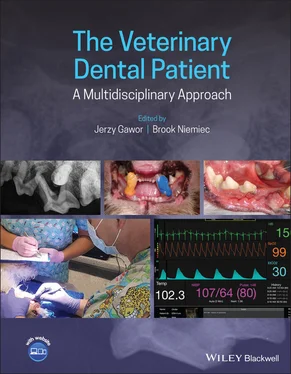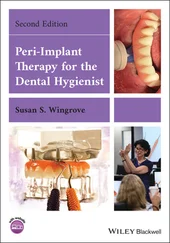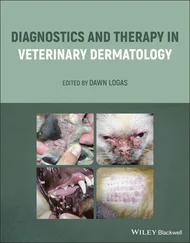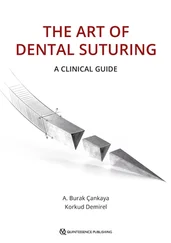5.3.4.2.3 Water Additives
This is a relatively new area of home dental care, with several products available ( Figure 5.14). While there are some studies on the human side that show the active ingredients have some efficacy (Hamp and Emilson 1973; Chapek et al. 1995), there is currently minimal to no peer‐reviewed evidence to support their use in controlling periodontal disease in veterinary patients. One product with xylitol 33 was shown to decrease plaque and calculus (Clarke 2006); there were concerns about its potential negative systemic effects (possible hypoglycemia and liver derangement) (Dunayer 2004, 2006; Xia et al. 2009), but it has been shown to be safe at the prescribed concentration (Anthony et al. 2011). Note that water additives will not work when the animal prefers tap water ( Figure 5.15).
Nitric oxide (NO) is an important inflammatory mediator that is seen in increased levels in human periodontitis (Matejka et al. 1998; Lappin et al. 2000). Products that decrease its production or effects may be helpful in the control of periodontal disease (Paquette and Williams 2000). Lactobacillus brevis is a probiotic bacteria containing high levels of arginine deiminase, which when applied topically decreases inflammatory mediators involved in periodontitis (Maekawa and Hajishengallis 2014).

Figure 5.14 The new version of Vet Aquadent without xylitol.

Figure 5.15 Water additives will not work when the animal prefers tap water.
1‐Tetradecanol complex (1‐TDC) B is an esterified monounsaturated fatty acid (MUFA) mixture of several fatty acids. In two in vivo studies on New Zealand rabbits, 1‐TDC stopped the progression of periodontal disease and caused a significant reduction in macroscopic periodontal inflammation, attachment, and bone loss (Hasturk et al. 2007, 2009).
5.3.4.2.6 Other Supplements
Plaque Off products containing seaweed (Ascophyllum nodosum) are available as ‘dental bites’ and powder to be added to the diet, and have systemic action possibly associated with stimulating the oral defense system and changing saliva content (Gawor et al. 2018) ( Figure 5.16).
Home care is a critical aspect of periodontal therapy, but it is often ignored. Early and consistent client education is the key to obtaining compliance. There are numerous options, but tooth brushing remains the gold standard. Of the products available for passive home care, only a few are truly effective, and the reader is urged to critically review the clinical studies when deciding which to recommend to their clients.

Figure 5.16 Plaque Off series.
1 Anthony, J.M.G., Weber, L.P., and Alkemade, S. (2011). Blood glucose and liver function in dogs administered a xylitol drinking water additive at zero, one and five times dosage rates. Vet. Sci. Dev. 1: e2.
2 Bjone, S., Brown, W., and Harris, A. (2007). Influence of chewing on dental health in dogs. Proceedings of the 16th European Congress of Veterinary Dentistry, pp. 45–46.
3 Bonesvoll, P. (1977). Oral pharmacology of chlorhexidine. J. Clin. Periodontol. 4: 49–65.
4 Booth, B.A. and Uitto, J. (1981). Collagen biosynthesis by human skin fibroblasts. III. The effects of ascorbic acid on procollagen production and prolyl hydroxylase activity. Biochim. Biophys. Acta. 675 (1): 117–122.
5 Boyce, E.N., Ching, R.J., Logan, E.I. et al. (1995). Occurrence of gram‐negative black‐pigmented anaerobes in subgingival plaque during the development of canine periodontal disease. Clin. Infect. Dis. 20 (Suppl. 2): S317–S319.
6 Brown, W.Y. and McGenity, P. (2005). Effective periodontal disease control using dental hygiene chews. J. Vet. Dent. 22 (1): 16–19.
7 Capik, I. (2007). Periodontal health vs. different preventative means in toy breeds – clinical study. Proceedings of the 16th European Congress of Veterinary Dentistry, pp. 31–34.
8 Chapek, C.W., Reed, O.K., and Ratcliff, P.A. (1995). Reduction of bleeding on probing with oral‐care products. Compend. Contin. Educ. Dent. 16 (2): 188–192.
9 Clarke, D.E. (2001). Clinical and microbiological effects of oral zinc ascorbate gel in cats. J. Vet. Dent. 18 (4): 177–183.
10 Clarke, D.E. (2006). Drinking water additive decreases plaque and calculus accumulation in cats. J. Vet. Dent. 23: 79–82.
11 Clarke, D.E., Kelman, M., and Perkins, N. (2011). Effectiveness of a vegetable dental chew on periodontal disease parameters in toy breed dogs. J. Vet. Dent. Winter 28 (4): 230–235.
12 Corba, N.H., Jansen, J., and Pilot, T. (1986a). Artificial periodontal defects and frequency of tooth brushing in beagle dogs (I). Clinical findings after creation of the defects. J. Clin. Periodontol. 13 (3): 158–163.
13 Corba, N.H., Jansen, J., and Pilot, T. (1986b). Artificial periodontal defects and frequency of tooth brushing in beagle dogs (II). Clinical findings after a period of healing. J. Clin. Periodontol. 13 (3): 186–189.
14 Cousido, M.C. (2009). In vivo substantivity of 0.12% and 0.2% chlorhexidine mouthrinses on salivary bacteria. Clin. Oral Investig. 14: 397–402.
15 Debowes, L.J. (2010). Problems with the gingiva. In: Small Animal Dental, Oral and Maxillofacial Disease, a Color Handbook (ed. B.A. Niemiec), 159–181. London: Manson.
16 Deery, C., Heanue, M., Deacon, S. et al. (2004). The effectiveness of manual versus powered toothbrushes for dental health: a systematic review. J. Dent. 32 (3): 197–211.
17 Dunayer, E.K. (2004). Hypoglycemia following canine ingestion of xylitol‐containing gum. Vet. Hum. Toxicol. 46 (2): 87–88.
18 Dunayer, E.K. (2006). New findings on the effects of xylitol ingestion in dogs. Vet. Med. 101 (12): 791–797.
19 Eaton, K.A., Rimini, F.M., Zak, E. et al. (1997). The effects of a 0.12% chlorhexidine‐digluconate containing mouthrinse versus a placebo on plauq and gingival inflammation over a 3‐month period. A multicentre study carried out in general dental practices. J. Clin. Periodontol. 24 (3): 189–197.
20 Fiorellini, J.P., Ishikawa, S.O., and Kim, D.M. (2006). Clinical features of gingivitis. In: Carranza's Clinical Periodontology (eds. F.A. Carranza, M.G. Newman, H.H. Takei and P.R. Klokkevold), 362–372. St. Louis, MO: W.B. Saunders.
21 Gawor, J., Jank, M., Jodkowska, K. et al. (2018). Effects of edible treats containing Ascophyllum nodosum on the oral health of dogs: a double‐blind, randomized, placebo‐controlled single‐center study. Front. Vet. Sci. 5: 168.
22 Gawor, J.P., Reiter, A.M., Jodkowska, K. et al. (2006). Influence of diet on oral health in cats and dogs. J. Nutr. 136: 2021S–2023S.
23 Gengler, W.R., Kunkle, B.N., Romano, D. et al. (2005). Evaluation of a barrier sealant in dogs. J. Vet. Dent. 22 (3): 157–159.
24 Gorrel, C. and Bierer, T.L. (1999). Long‐term effects of a dental hygiene chew on the periodontal health of dogs. J. Vet. Dent. 16 (3): 109–113.
25 Gorrel, C. and Rawlings, J.M. (1996). The role of tooth‐brushing and diet in the maintenance of periodontal health in dogs. J. Vet. Dent. 13 (4): 139–143.
Читать дальше















